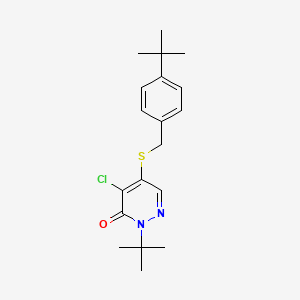D0297 | Pyridaben
| Toxicity | Dose | Time | Species | Model | Method | Action | Positive criterion | Reference |
|---|---|---|---|---|---|---|---|---|
| ELECTRON TRANSPORT CHAIN | 2.4 nM | NADH–Q-1 | decrease | IC50 | 108 | |||
| GLUCOSE GALACTOSE IC50 RATIO | 75000 | LUHMES (Lund human mesencephalic) cells | Glc–Gal–NeuriTox assay | EC25(NA) [Glc/Gal] | 326 | |||
| Target | Dose | Time | Species | Model | Method | Action | Positive criterion | Reference |
|---|---|---|---|---|---|---|---|---|
| NADH:ubiquinone reductase | 2.4 nM | NADH–Q-1 | inhibitor | IC50 | 108 | |||
| Pictogram | Signal | Statements | Precautionary Statement Codes |
|---|---|---|---|
  |
Danger |
H301: Toxic if swallowed [Danger Acute toxicity, oral] H331: Toxic if inhaled [Danger Acute toxicity, inhalation] H400: Very toxic to aquatic life [Warning Hazardous to the aquatic environment, acute hazard] H410: Very toxic to aquatic life with long lasting effects [Warning Hazardous to the aquatic environment, long-term hazard] |
P261, P264, P270, P271, P273, P301+P310, P304+P340, P311, P321, P330, P391, P403+P233, P405, and P501; (The corresponding statement to each P-code can be found at the GHS Classification page.) |
  |
Danger |
Aggregated GHS information provided by 90 companies from 3 notifications to the ECHA C&L Inventory. Each notification may be associated with multiple companies. H301 (100%): Toxic if swallowed [Danger Acute toxicity, oral] H331 (100%): Toxic if inhaled [Danger Acute toxicity, inhalation] H400 (100%): Very toxic to aquatic life [Warning Hazardous to the aquatic environment, acute hazard] H410 (100%): Very toxic to aquatic life with long lasting effects [Warning Hazardous to the aquatic environment, long-term hazard] Information may vary between notifications depending on impurities, additives, and other factors. The percentage value in parenthesis indicates the notified classification ratio from companies that provide hazard codes. Only hazard codes with percentage values above 10% are shown. |
P261, P264, P270, P271, P273, P301+P310, P304+P340, P311, P321, P330, P391, P403+P233, P405, and P501; (The corresponding statement to each P-code can be found at the GHS Classification page.) |
  |
Danger |
Aggregated GHS information provided by 195 companies from 3 notifications to the ECHA C&L Inventory. Each notification may be associated with multiple companies. H301+H331 (78.97%): Toxic if swallowed or if inhaled [Danger Acute toxicity, oral acute toxicity, inhalation] H301 (100%): Toxic if swallowed [Danger Acute toxicity, oral] H331 (100%): Toxic if inhaled [Danger Acute toxicity, inhalation] H400 (100%): Very toxic to aquatic life [Warning Hazardous to the aquatic environment, acute hazard] H410 (100%): Very toxic to aquatic life with long lasting effects [Warning Hazardous to the aquatic environment, long-term hazard] Information may vary between notifications depending on impurities, additives, and other factors. The percentage value in parenthesis indicates the notified classification ratio from companies that provide hazard codes. Only hazard codes with percentage values above 10% are shown. |
P261, P264, P270, P271, P273, P301+P310, P304+P340, P311, P321, P330, P391, P403+P233, P405, and P501; (The corresponding statement to each P-code can be found at the GHS Classification page.) |
  |
Danger |
H301: Toxic if swallowed [Danger Acute toxicity, oral] H331: Toxic if inhaled [Danger Acute toxicity, inhalation] H410: Very toxic to aquatic life with long lasting effects [Warning Hazardous to the aquatic environment, long-term hazard] |
P261, P264, P270, P271, P273, P301+P310, P304+P340, P311, P321, P330, P391, P403+P233, P405, and P501; (The corresponding statement to each P-code can be found at the GHS Classification page.) |
   |
Danger |
H302: Harmful if swallowed [Warning Acute toxicity, oral] H331: Toxic if inhaled [Danger Acute toxicity, inhalation] H371: May cause damage to organs [Warning Specific target organ toxicity, single exposure] |
P260, P261, P264, P270, P271, P301+P312, P304+P340, P309+P311, P311, P321, P330, P403+P233, P405, and P501; (The corresponding statement to each P-code can be found at the GHS Classification page.) |
| 2 -t-butyl-5-(p-t-butylbenzylthio)-4-chloro-3(2H)-pyridazinone | 2-t-butyl-5-(p-t-butylbenzylthio)-4-chloro-3(2H)-pyridazinone | 2-tert-Butyl-5-(4-tert-Butylbenzylthio)-4-chloropyridazin-3(2H)-one |
| 2-tert-Butyl-5-(4-tert-butyl-benzylthio)-4-chloropyridazin-3(2H)-one | 2-tert-Butyl-5-[(4-tert-butylbenzyl)sulfanyl]-4-chloro-3(2H)-pyridazinone # | 2-tert-Butyl-5-{[(4-tert-butylphenyl)methyl]sulfanyl}-4-chloropyridazin-3(2H)-one |
| 2-tert-butyl-4-chloro-5-(4-tert-butylbenzyl) thio 3(2H)-pyridazinone | 2-tert-butyl-4-chloro-5-(4-tert-butylbenzyl)thio 3(2H)-pyridazinone | 2-tert-butyl-5-[(4-tert-butylbenzyl)thio]-4-chloro-pyridazin-3-one |
| 2-tert-butyl-5-[(4-tert-butylbenzyl)thio]-4-chloropyridazin-3(2H)-one | 2-tert-butyl-5-[(4-tert-butylphenyl)methylsulfanyl]-4-chloranyl-pyridazin-3-one | 2-tert-butyl-5-[(4-tert-butylphenyl)methylsulfanyl]-4-chloropyridazin-3-one |
| 2-tert-butyl-5-[(4-tert-butylphenyl)methylthio]-4-chloro-3-pyridazinone | 2-tert.-butyl-4-chloro-5-(4-tert.-butyl-benzylthio)-3(2H)-pyridazinone | 2-tert.-butyl-4-chloro-5-(4-tert.-butylbenzylthio)-3(2H)-pyridazinone |
| 2E4JBA5272 | 3(2H)-Pyridazinone, 4-chloro-2-(1,1-dimethylethyl)-5-(((4-(1,1-dimethylethyl)phenyl)methyl)thio)- | 3(2H)-Pyridazinone, 4-chloro-2-(1,1-dimethylethyl)-5-[[[4-(1,1-dimethylethyl)phenyl]methyl]thio]- |
| 4-chloro-2-(1,1-dimethylethyl)-5-(((4-(1,1-dimethylethyl)phenyl)methyl)thio)-3(2H)-pyridazinone | 489P713 | 96489-71-3 |
| AB0015419 | ACT03255 | AKOS015897404 |
| BDBM58401 | C-20997 | C18614 |
| C19H25ClN2OS | CAS-96489-71-3 | CC-34094 |
| CHEBI:38626 | CHEMBL225963 | DSSTox_CID_12573 |
| DSSTox_GSID_32573 | DSSTox_RID_78991 | DTXSID5032573 |
| DWFZBUWUXWZWKD-UHFFFAOYSA- | DWFZBUWUXWZWKD-UHFFFAOYSA-N | EC 405-700-3 |
| FT-0082433 | FT-0630993 | HMS2885L11 |
| HSDB 7052 | InChI=1/C19H25ClN2OS/c1-18(2,3)14-9-7-13(8-10-14)12-24-15-11-21-22(19(4,5)6)17(23)16(15)20/h7-11H,12H2,1-6H3 | J90047 |
| KM3423 | KS-1098 | LS-129791 |
| M865 | MLS001165698 | NCGC00164309-01 |
| NCGC00164309-02 | NCGC00164309-03 | NCGC00254990-01 |
| NCI 129 | Pyridaben | Pyridaben 10 microg/mL in Cyclohexane |
| Pyridaben 100 microg/mL in Acetonitrile | Pyridaben 100 microg/mL in Methanol | Pyridaben 1000 microg/mL in Methanol |
| Pyridaben [ISO] | Pyridaben, PESTANAL(R), analytical standard | Q2119916 |
| SCHEMBL27429 | SMR000550490 | SR-01000789284 |
| SR-01000789284-2 | SR-01000789284-3 | Sanmite |
| Tox21_301090 | UNII-2E4JBA5272 | ZINC1543237 |
| cid_91754 |

